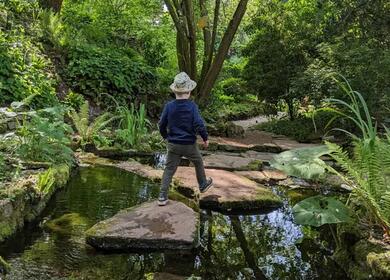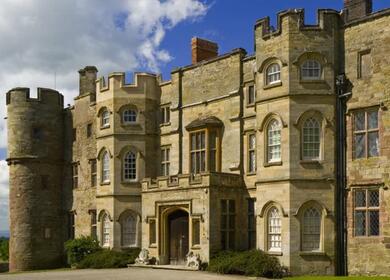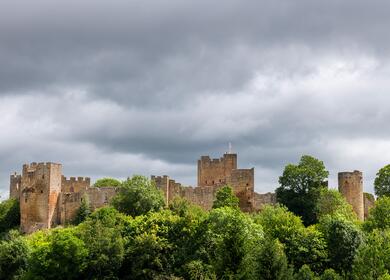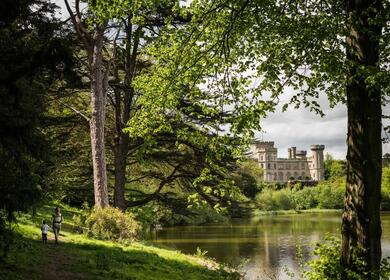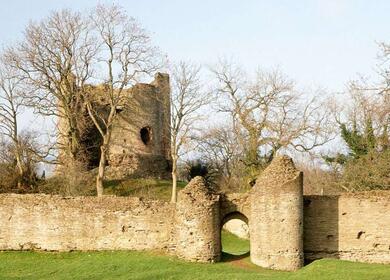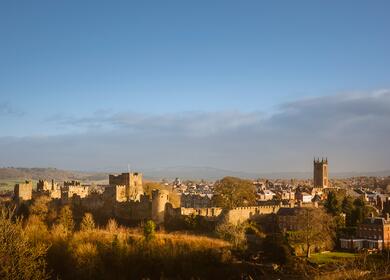
The counties of Herefordshire and Shropshire sat right at the heart of the strategically important Welsh Marches back in medieval times. The Marches were a buffer zone between England and Wales and at one point there were more castles in this area than in many other parts of England!
Today, some remain quite intact, others less so. But we think they’re all worth a look so here's a brief guide:
Hampton Court Castle & gardens
Pearl Lake – 28 mins
Arrow Bank – 19 mins
Rockbridge – 36 mins
Important fact alert – Hampton Court Castle isn’t really a castle! It’s technically a fortified manor house rather than a proper defensive castle – but it does look absolutely like you’d expect a castle to look!
Hampton Court has had an up and down history dating back to 1427. It’s changed hands many times including in the 1800’s to the son of leading industrialist and inventor Richard Arkwright, unimaginatively also called Richard!
Richard jnr changed the facade to a Neo Gothic style that was very popular at the time and is still visible today. From a WW1 military convalescent hospital to being fairly crumbly in the 1960’s it’s now been fully restored and operates as a tourist attraction and wedding venue.
Several rooms have been restored including the Great Hall and Chapel. There are stunning gardens including the walled ornamental kitchen garden and beautiful borders. The Yew Tree Maze with a gothic tower as its centrepiece is a must see.
There’s a river walk, a sunken garden with a waterfall and a ha-ha wall with views of the Herefordshire countryside at every turn. A 170-year-old Wisteria Arch in full bloom is a thing of beauty. Award-Winning Days Out at Hampton Gardens in Herefordshire.
The property is privately owned so check the website for opening times.
Croft Castle
Pearl Lake -11mins
Arrow Bank - 15mins
Rockbridge – 22mins
Croft Castle - owned by the Croft family from the 11th century, the castle is now run by the National Trust. Originally a mediaeval stronghold its current facade is mainly 18th century.
Dating back to around 1085, Croft was built by Norman knight, Bernard de Croft. Like so many castles in the area, Croft has undergone many changes to its facade. Its current ‘look’ dates from the late 1600’s - four round towers at each corner with an internal quadrangle.
Croft has bobbed in and out of the ownership of the Croft family – generally being sold when finances were tight. In the 1950’s it faced demolition but was saved by Diana Croft and passed to the National Trust in 1957.
Today it’s Grade 1 listed and visitors can walk around the interior and see the rooms that have been beautifully restored. Outside there are 1500 acres of historic park and farmland, a secret garden, kitchen garden with a working vineyard. Well worth a day out!
Ludlow Castle
Pearl Lake - 25mins
Arrow Bank – 29mins
Rockbridge – 36mins
Ludlow Castle is one of the most significant medieval fortresses in England. Set above the town is has stunning views over the Shropshire countryside.
Building began in the late 11th century by Walter de Lacy who was tasked with calming things down in the Welsh Marches.
Down the centuries it was regularly enlarged and fortified. During the English Civil War, it was held by the Royalist but after their surrender the castle fell into decline.
The government of the day in the 1760’s considered demolishing Ludlow Castle but instead it was leased to the Earl of Powis and became an early tourist attraction. It’s now owned by the Powis Castle Estate.
In the 1950’s the ruins were being worked on to make them safe for increasing number of visitors and to this day there are ongoing conservation projects and work.
The castle is home to Ludlow Festival, where open-air performances of Shakespeare are put on in the grounds. Ludlow Food Festival is held within the walls.
Wigmore Castle
Pearl Lake – 11mins
Arrow Bank - 16mins
Rockbridge – 22mins
Wigmore Castle is situated in North Herefordshire but close to both the Shropshire and Welsh borders made Wigmore Castle an important strategic building and its history spans over 900 years.
Unlike the other castles we’ve looked at, Wigmore is a true ruin but is considered to be one of the most remarkable in England.
After the Norman Conquest, it became a stronghold of the Mortimer family who controlled vast lands along the English-Welsh border and used Wigmore as their principal seat. By the late 1400’s however, and the threat from the Welsh declined, Wigmore Castle fell into disrepair. It remained unloved for centuries, slowly decaying and being taken over by nature.
English Heritage began preservation work in the early 2000’s to keep it ‘as found’ and to retain its wild, overgrown character. It’s home to unusual species of wildlife including lesser horseshoe bats and wildflowers including the ploughman’s spikenard.
It’s free to enter the ruin but be careful as there are lot’s steep steps and inclines.
Eastnor Castle
Pearl Lake – 54mins
Arrow Bank – 50mins
Rockbridge – 65mins
Like Hampton Court, Eastnor is a castle in name only and by comparison to the other castles in the area – it's very young!
Eastnor is a striking 19th-century Gothic Revival mansion nestled in the foothills of the Malvern Hills near Ledbury, in east Herefordshire. Built between 1811 and 1820 by the 1st Earl of Somers. The design very much reflected a medieval castle with battlements, towers and a keep. The interior was designed by Augustus Pugin who was big in the gothic revival movement of the time.
Eastnor is currently the family home of the Hervey-Bathhurst family who are decedents of the original owners. Check out the website for opening times HERE
There’s loads to see inside and outside at Eastnor. There’s opulent rooms full of period furniture the highlight of which is the Gothic Drawing Room. The 5,000-acre estates include a deer park and closer to the castle there’s a maze, arboretum and lake all with the stunning backdrop of the Malvern Hills.
Longtown Castle
Pearl Lake - 58mins
Arrow Bank - 53mins
Rockbridge – 60mins
Longtown Castle, in the Herefordshire village of Longtown is a Norman motte (a large mound of earth) and bailey (a courtyard) castle.
It’s another Welsh Borderlands castle that was constructed to keep the Welsh at bay and which was originally built of timber but then rebuilt in stone in the mid-12th century. The castle played a huge role in the turbulent times of the Welsh marches during the 13th and 14th centuries. However, by the late Middle Ages, the castle’s fortunes had changed. It was purposely damaged to prevent it being used and stone from the castle was used in local buildings.
Now owned by English Heritage, the round keep is clear to see, looking towards the Black Mountains. You can see the earthworks that reveal the size of the old castle and of course the views are unparalleled.
Entry to Longtown Castle is free but check the English Heritage website for opening times.

